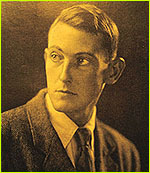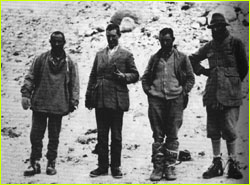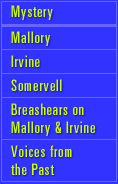
|
 |
 |
by Audrey Salkeld George Leigh Mallory was the only climber to take part in all three of the British pioneering expeditions to Mount Everest in the 1920s. Born in 1886, he died a few days short of his 38th birthday, while making a summit attempt with his young companion, Andrew Irvine. Mallory was the son of a clergyman, an idealist and a romantic, and he was married with three small children. A schoolmaster by profession, he switched in 1923 from teaching boys to teaching adults, which he found very rewarding. During the Great War of 1914-18 he had served at the front as a gunner. He was a neat and bold rock climber and a competent ice climber, but his greatest assets were vivacity and a love of adventure. He would seize the moment and encourage his fellow climbers to follow. If he had a weakness, it was the failure to recognize when he had given enough. He was charismatic and endearingly absent-minded, though this could have proved a fatal flaw. Those who set off on the reconnaissance trip of 1921 had no idea what they were up against. But as Mallory put it, "to refuse the adventure is to run the risk of drying up like a pea in its shell." They were walking off the known map, with high hopes of scaling a mountain no Westerner had ever seen at close quarters, venturing into atmospheres thinner than anyone had climbed into before. For its day, going to Everest was like going to the moon. The small, poorly equipped little band, dressed in an assortment of tweeds and home-knits, challenged Himalayan heights with little to assist them beyond the indomitable spirit of Empire. Though visible as a small bump on the horizon from the Indian hill station of Darjeeling, Everest had remained remote because it straddled the border between Tibet and Nepal and both countries were at the time strictly out of bounds to travelers. Having at last negotiated permission to enter Tibet, the expedition set off on a six-week approach march, exploring and surveying as they went, and carrying out a "photographic offensive" on the mountains and medieval culture of rural Tibet.
Instead, Mallory and Bullock led a small group to the North Col by a long route from the east, over the Lakpa La. They breasted the col in a fierce gale and were soon forced back the way they had come, but although conditions were unfavorable for a proper attempt on the mountain that year, Mallory was convinced that a clear route existed all the way to the summit.
When plans were formulated for a third attempt in 1924 Mallory was unsure whether he wanted to go again to Everest. He had just started a new job in Cambridge, which suited him very well, and his family had joined him there. In ten years of marriage he and his wife Ruth had found themselves apart as much as they had been together, separated first by war and then by repeated Everest trips and lecture tours. It was a wrench to leave home again, but in the end Mallory thought it would be rather grim to see others, without him, engaged in conquering the summit. "I have to look at it from the point of view of loyalty to the expedition," he wrote to his father as he vacillated, "and of carrying through a task begun."
Back to Mystery of Mallory & Irvine Read Mallory's letters to his wife. Photos: (1,4) Salkeld Collection; (2) Finch Collection, courtesy of Mrs. Scott Russell. Lost on Everest | High Exposure | Climb | History & Culture | Earth, Wind, & Ice E-mail | Previous Expeditions | Resources | Site Map | Everest Home Editor's Picks | Previous Sites | Join Us/E-mail | TV/Web Schedule About NOVA | Teachers | Site Map | Shop | Jobs | Search | To print PBS Online | NOVA Online | WGBH © | Updated November 2000 |
 George Leigh Mallory
George Leigh Mallory
 Return from First Summit Attempt, 1922; Morshead,
Mallory, Somervell, Norton (L to R).
Return from First Summit Attempt, 1922; Morshead,
Mallory, Somervell, Norton (L to R).
 Mallory with his wife, Ruth
Mallory with his wife, Ruth
